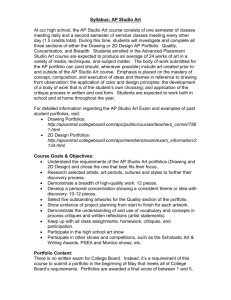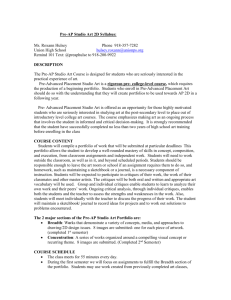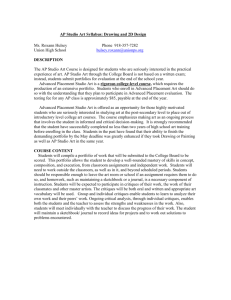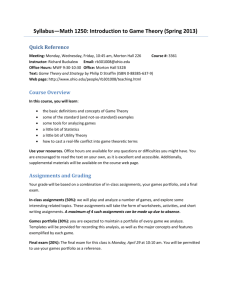AP 2D Design Syllabus
advertisement
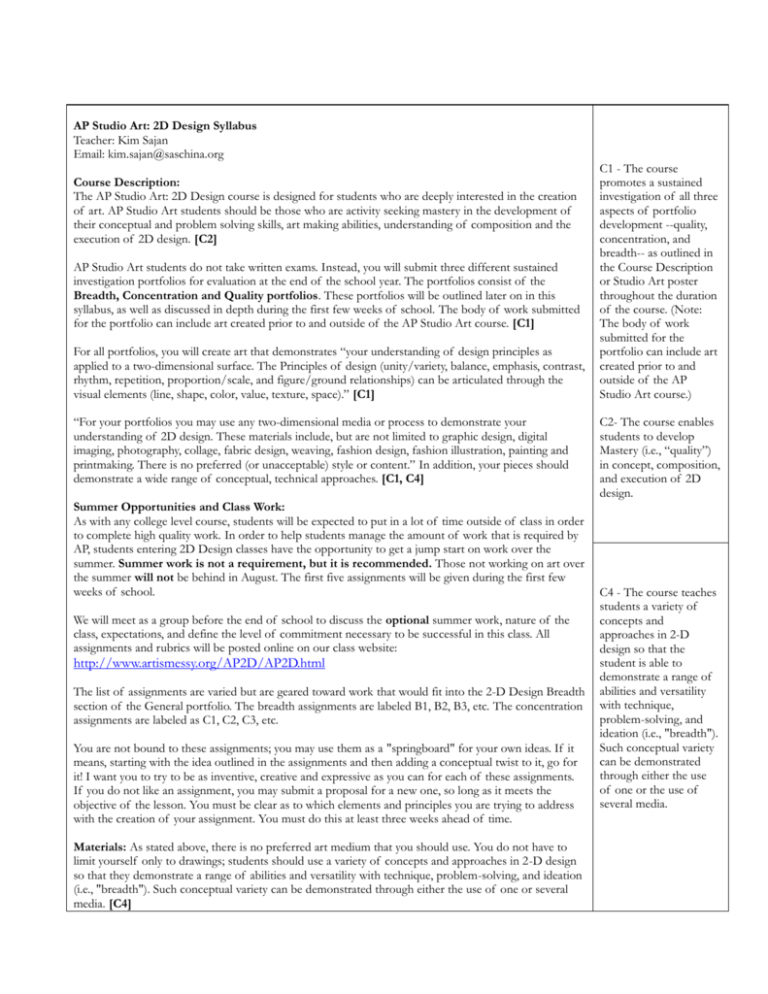
AP Studio Art: 2D Design Syllabus Teacher: Kim Sajan Email: kim.sajan@saschina.org Course Description: The AP Studio Art: 2D Design course is designed for students who are deeply interested in the creation of art. AP Studio Art students should be those who are activity seeking mastery in the development of their conceptual and problem solving skills, art making abilities, understanding of composition and the execution of 2D design. [C2] AP Studio Art students do not take written exams. Instead, you will submit three different sustained investigation portfolios for evaluation at the end of the school year. The portfolios consist of the Breadth, Concentration and Quality portfolios. These portfolios will be outlined later on in this syllabus, as well as discussed in depth during the first few weeks of school. The body of work submitted for the portfolio can include art created prior to and outside of the AP Studio Art course. [C1] For all portfolios, you will create art that demonstrates “your understanding of design principles as applied to a two-dimensional surface. The Principles of design (unity/variety, balance, emphasis, contrast, rhythm, repetition, proportion/scale, and figure/ground relationships) can be articulated through the visual elements (line, shape, color, value, texture, space).” [C1] “For your portfolios you may use any two-dimensional media or process to demonstrate your understanding of 2D design. These materials include, but are not limited to graphic design, digital imaging, photography, collage, fabric design, weaving, fashion design, fashion illustration, painting and printmaking. There is no preferred (or unacceptable) style or content.” In addition, your pieces should demonstrate a wide range of conceptual, technical approaches. [C1, C4] Summer Opportunities and Class Work: As with any college level course, students will be expected to put in a lot of time outside of class in order to complete high quality work. In order to help students manage the amount of work that is required by AP, students entering 2D Design classes have the opportunity to get a jump start on work over the summer. Summer work is not a requirement, but it is recommended. Those not working on art over the summer will not be behind in August. The first five assignments will be given during the first few weeks of school. We will meet as a group before the end of school to discuss the optional summer work, nature of the class, expectations, and define the level of commitment necessary to be successful in this class. All assignments and rubrics will be posted online on our class website: http://www.artismessy.org/AP2D/AP2D.html The list of assignments are varied but are geared toward work that would fit into the 2-D Design Breadth section of the General portfolio. The breadth assignments are labeled B1, B2, B3, etc. The concentration assignments are labeled as C1, C2, C3, etc. You are not bound to these assignments; you may use them as a "springboard" for your own ideas. If it means, starting with the idea outlined in the assignments and then adding a conceptual twist to it, go for it! I want you to try to be as inventive, creative and expressive as you can for each of these assignments. If you do not like an assignment, you may submit a proposal for a new one, so long as it meets the objective of the lesson. You must be clear as to which elements and principles you are trying to address with the creation of your assignment. You must do this at least three weeks ahead of time. Materials: As stated above, there is no preferred art medium that you should use. You do not have to limit yourself only to drawings; students should use a variety of concepts and approaches in 2-D design so that they demonstrate a range of abilities and versatility with technique, problem-solving, and ideation (i.e., "breadth"). Such conceptual variety can be demonstrated through either the use of one or several media. [C4] C1 - The course promotes a sustained investigation of all three aspects of portfolio development --quality, concentration, and breadth-- as outlined in the Course Description or Studio Art poster throughout the duration of the course. (Note: The body of work submitted for the portfolio can include art created prior to and outside of the AP Studio Art course.) C2- The course enables students to develop Mastery (i.e., “quality”) in concept, composition, and execution of 2D design. C4 - The course teaches students a variety of concepts and approaches in 2-D design so that the student is able to demonstrate a range of abilities and versatility with technique, problem-solving, and ideation (i.e., "breadth"). Such conceptual variety can be demonstrated through either the use of one or the use of several media. Size of Artwork: With the exception of sketchbook work, all pieces are to be no smaller than 12 x 16.” 18” x 24” is the maximum size of originals that can be sent to the College Board. If you are working on canvas or wooden boards, you can create art up to the 18 X 24” in size. If you are working on paper or canvas sheets and are planning on mating your work, the outside edge of your frame can not be bigger than 18 X 24”. Thus, assuming you have a 1.5 inch frame all around, the maximum size for your art is 15 x 21” If you are planning on a 2 inch frame then 14 x 20 is the maximum size for your pieces. THE THREE PORTFOLIOS: In order for you to understand the differences between the three portfolios and what is meant by 2D Design, we will spend time during the first weeks of school looking at online examples of student work from years past. As a class we will grade these works according to the AP rubric and then compare our scores to AP. This moderation will help you understand the level of quality at each mark band. Breadth Portfolio For this portfolio, you will be submitting 12 digital images of 12 different works that “demonstrate an understanding of the principles of design, including unity/variety, balance, emphasis, contrast, rhythm, prepetition, proportion/scale and figure ground relationship. Successful works of art require the integration of the elements and principles of design; students must therefore be actively engaged with these concepts while thoughtfully composing their art. The work in this section should show evidence of conceptual, perceptual and expressive development, as well as technical skill.” This section requires works in which the elements and principles of two-dimensional design are the primary focus; students are asked to demonstrate that they are thoughtfully applying these principles while composing their art. These works should demonstrate the student’s visual organization skills. The best demonstrations of breadth clearly show experimentation and a range of conceptual approaches to the work. It is possible to do this in a single medium or in a variety of media.” [C4, C5] Concentration (Sustained Investigation) Portfolio For this portfolio, you will be submitting 12 digital images of work that are “a sustained and thoughtful investigation of a specific visual idea.” “They may include detail views, process documentation, sequential storyboards, or film stills.” You are “encouraged to explore a personal, central interest as intensively as possible. You are free to work with any idea in any medium that address two dimensional design issues. The concentration should grow out of the idea and demonstrate growth through a number of conceptually related works.” [C3] With this portfolio you are asked to include a written commentary that “describes what the concentration is and how it evolved. You are asked to respond to the following: Clearly and simply state the central idea of your concentration. Explain how the work in your concentration demonstrates your intent and the exploration of your idea. You may refer to specific images as examples.” [C3] You will not be graded on this written component by AP. C4, C5 - The course teaches students a variety of concepts and approaches in 2-D design so that the student is able to demonstrate a range of abilities and versatility with technique, problem-solving, and ideation (i.e., "breadth"). Such conceptual variety can be demonstrated through either the use of one or the use of several media. C3 - The course enables students to develop a body of work investigating a strong underlying visual idea in 2-D design that grows out of a coherent plan of action or investigation (i.e., a "concentration"). Over the summer, you should begin thinking about a theme/subject/studio investigation that you want to pursue in depth next year for the concentration component of the AP portfolio. A list of concentration topics from pervious years can be found at: You may select something from the list or create your own idea. Once you have decided upon an idea, begin to bring in ideas, sketches, notes and research on your theme. I always recommend researching images of art that deal with similar ideas. I suggest this for you to be inspired, not for you to copy their work. Check out the following link for a list of topics done by students from years past: http://www.artismessy.org/AP2D/Concentration_Ideas.html Quality Portfolio You will be submitting five actual pieces in one or more media for this portfolio after Spring Break. These works should be of high quality in terms of the concept, execution and execution of 2D design. C2- The course enables students to develop Mastery (i.e., “quality”) in concept, composition, and execution of 2D design. Though variety is not a requirement for the Quality Portfolio, I encourage you to submit a variety of subjects, media, techniques or processes. These works will be mailed off to AP sometime in late early May. The pieces will be returned to you after they are reviewed. [C2] The works can come from your Breadth or Concentration portfolios, but they do not have to. Work from outside of class can be submitted so long as it is 100% your own. Art tutors may not assist in the creation of any work for AP. They must be completed on flat surfaces such as paper, canvas board, wooden board, cardboard or unstretched canvas and can be no larger than 18 x 24” if unmated. Mats are optional, but are recommended. Course Schedule Classes meet every other day for 80 minutes. The course focuses on both sections of the portfolio (Breadth and Concentration) throughout the year, with the best artwork selected for use in the Quality section of the AP Studio Art portfolio. The Breadth work is generally teacher driven and completed in the first semester of the year. The Concentration is student driven, but deadlines are set to complete the work in time to photograph this section of the portfolio. During the month of April, selections of your portfolios will be on display in the PAC. You will be responsible for curating the display of your pieces, as well as creating name cards and writing artists statements. This is a very public event, so it is expected that your presentations will be spotless. Ideation and Conferencing, and Critiques Art making is an ongoing process that is refined through practice and informed by the exposure to new ideas and images. This course will provide you with the needed stimulus to help you develop high quality pieces. [C7] We will examine different ways artists generate ideas. Mind mapping, concept charts, random generators, and other thinking protocols will be covered in class. [C6] Prior to the start of a project, class time will be spent conferencing with myself or your peers in order to help you clarify your idea. In order for us to have informed conversations about your work, please bring your sketchbook to class each day. Your sketchbook should contain thumbnail drawings, as well as any images that might serve as inspiration or as references. [C7] There will be many opportunities for feedback throughout the course. I will provide you with daily formative feedback on your work through individual conferences. We will use small group peer discussions in order to provide more feedback. Finally, we will have whole class “speed dating style” of critiques where the entire class will comment on each other’s work. These critiques will be done prior to the completion of a project so there is still time to make additional changes. [C8, C9] Students are expected to conduct themselves in a positive manner allowing for honest and open discussions. All students are required to participate in these critiques both showing their work and commenting on others. All critiques will be frame by using the “I Like…” stem for positive feedback and “I wonder….” for suggestions. [C9] Academic and Artistic Integrity This art class should stretch your artistic abilities and your imagination. The course expects that you create original and personal work which is not copied from other sources. You are expected to practice artistic integrity at all times! “Any work that makes use of other artists’ work (including photographs) and/or published images must show substantial and significant development beyond duplication. This may be demonstrated through manipulation of the formal qualities, design, and/or concept of the original work. It is unethical, constitutes plagiarism, and often violates copyright law simply to copy an image (even in another medium) that was made by someone else.” (AP Art Handbook) [C10] Artistic integrity also includes taking responsibility and not allowing someone else to physically do your work for you. Turning in someone else’s work with your name on it is cheating. The school cheating policy will be strictly enforced, and you will need to create an entirely new project within a designated amount of time. [C10] C7- The course emphasizes making art as an ongoing process that involves the student in informed and critical decision making. C6-The course teaches students a variety of concepts and approaches in 2-D design so that the student is able to demonstrate a range of abilities and versatility with technique, problem-solving, and ideation (i.e., "breadth"). Such conceptual variety can be demonstrated through either the use of one or the use of several media. C8, C9- The course includes group and individual student critiques and instructional conversations with the teacher, enabling students to learn to analyze and discuss their own artworks and those of their peers. C10 - The course teaches students to understand artistic integrity as well as what constitutes plagiarism. If students produce work that makes use of photographs, published images, and/or other artists' works, the course teaches students how to develop their own work so that it moves beyond duplication. Should you commit a form of academic dishonesty the following steps will be followed: A Log entry for ALL levels of academic dishonesty will be made. You will be given an alternative assignment and assessment. This assignment is exempt from the resubmittal policy stated above. Consequences will be administered by Mrs. Doleman, Ms. McKenna or Dr. Heckmann We will follow these guidelines in class. Within the first few weeks of school we will explore this policy further. We will discuss ways reference photos are appropriately used in the creation of a unique piece of art. Failure to do so will result in serious academic consequences. If you are in doubt about copyright issues, save your self some trouble and just take your own reference photos for your projects. [C10] Grading Policy Summative assessments are calculated together to get your final grade in this class. Summative Assessments may include sketchbook work, final projects, presentations and self reflections. Summative assessments are worth 100% of your final grade. Formative assessments are also entered into gradebook, but they are not mathematically factored into your final grade. Formative assessments may include homework, media experiments, and research. Grades will be updated on Powerschool on a regular basis. If there is a grade issue, please see me before or after school to discuss it. Grades will not be discussed during class, as class time is for making art. Powerschool automatically rounds up grades, therefore grades will not be changed unless there is a human error. Rubrics Specific rubrics will be provided with each unit so you will know what is expected of you before you even begin the project. These rubrics are posted on each project page of this website. If you do not understand what is expected of you, it is your responsibility to come to me for clarification. Homework If homework is not completed by the start of the class, you will be given the opportunity to complete it THAT day in the Second Chance Room (SCR). You will need to turn it in to me before school begins the very next day. Should you choose not to, you will be given additional chances to visit the SCR until it is finished. Formative homework assignments will not be graded, but will be marked “missing” in Gradebook if not handed in. Summative Homework assignments will be graded and marked with an “incomplete” if not handed in. Retake Policy Projects or individual components may be reworked in order to better demonstrate your learning. The request to rework an assignment must be made within 3 days of receiving your assignment or project grade. You will need to complete a re-submittal plan that outlines the learning that you plan to demonstrate, and have it approved by your teacher before the project can be revised. After the form has been turned in, you and your teacher will discuss your learning plan. All reworked/resubmitted pieces are due by the end of the next project. Late and Incomplete Work Late work due to absences and emergencies: It is your responsibility to check for missed assignments and to turn in missing work. In the case of emergencies and serious illnesses, other accommodations between the student and teacher will be arranged. If the assignment is not turned in, a “Missing” will be entered into Powerschool and your overall grade will be overwritten with an “Incomplete” if there is insufficient evidence to assess learning. At this point in time parents, counselors and administrators will be contacted about your missing work. C10 - The course teaches students to understand artistic integrity as well as what constitutes plagiarism. If students produce work that makes use of photographs, published images, and/or other artists' works, the course teaches students how to develop their own work so that it moves beyond duplication. General late work: Assignments are designed so that the majority of work can be done in class. If homework is not completed for the start of the class, you will be given the opportunity to complete it THAT day in the Second Chance Room. You will need to turn it in to me at the end of the day that you are assigned second chance. Should you choose not to complete your work, you will be given additional chances to visit the SCR until it is finished. Major Projects: If you do not complete or turn in a major project, the following steps will occur: Log Entry: Parents, administrators and counselors are contacted immediately when projects are not turned in. Second Chance Room (SCR): you will be given the opportunity to complete your project in the SCR. If the project is not completed at the end of the session, you will automatically be assigned to the SCR until the work is done. The project will be marked as Missing in Gradebook. Additionally, your grade will be temporally changed to an Incomplete until a grade is given for the assessment. A zero will replace the Missing/Incomplete grade if the work is not submitted by the first day of exams. Learner Profile Active Learner: Active learning is contributing to class discussions, group brainstorming sessions and critiques. Time and effort goes into the planning and design of projects, as well as pushing the boundaries and going beyond the minimum requirements. Integrity: In addition to following the SAS Academic Honesty guidelines in the Student Handbook, a student demonstrating integrity is focused and on task at all times- no Skype, games, texting, etc. Responsibility: Responsibility includes meeting deadlines, being prepared for class, and helping to clean up. Resources Here are some recommended readings to help further develop your knowledge of art. Experimental Drawing by Robert Kaupelis Design Synectics by Nicholas Roukes Art Synectics by Nicholas Roukes From Ordinary to Extraordinary by Ken Vieth Design Principles and Problems 2nd Ed. by Paul Zelanski and Mary Pat Fisher Design and Composition by Nathan Goldstein Color and Light by James Gurney I have read and understood the course rules and expectations for AP Art: 2D Design. I will try my best to be original, creative, and above all practice artistic integrity. I understand my responsibilities and the consequences of the choices that I make. Student Name (Printed): Parent Name (Printed): Parent Email and Phone Number: Student Signature: Parent Signature:



